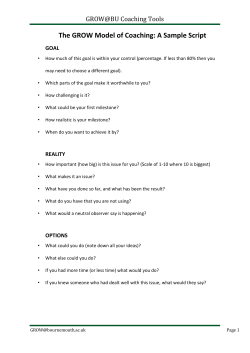
Motivating and Developing Others
Motivating and Developing Others Beth Mertz, PhD, MA Preventive and Restorative Dental Sciences The Center for Health Professions University of California, San Francisco Session Objectives • Review general factors important in motivation of employees • Understand a specific model for leading the development and ongoing performance of your team • Discuss the six “C’s’ for guiding behavior • Your goals/questions? 2 3 Motivation 4 Motivation • Most people want to be successful • Systems can engage this natural motivation, or they can extinguish it • Take a minute and write down what motivates you? 5 Motivation Factors Factors leading to extreme dissatisfaction Factors leading to extreme satisfaction Achievement Recognition Work Itself Responsibility Advancement Growth Company Policy Supervision Relationship with Supervisor Work Conditions Salary Relationship with Peers -50 Hygiene -30 -10 10 30 Motivators Source: Herzberg, F, One More Time: How do you motivate employees, HBR 1990. A meta analysis of 12 studies of critical incidents. 50 6 Keys to Motivation • Competence – the skills to do the task successfully, or the ability to gain them • Meaningfulness – comprehension of the significance and value of the work • Choice – some involvement in deciding the scope of work and how it is to be done • Progress – feedback on work including rewards tied to performance* *http://www.washingtonpost.com/blogs/on-leadership/wp/2014/01/27/study-finds-that-basically-every-single-personhates-performance-reviews/ 7 How many have done, or know of their type on Myers-Briggs Type Indicator? ENERGY • Introversion (I) • Extroversion DATA GATHERING • iNtuitive (N) • Sensing DECISION MAKING • Feeling (F) • Thinking ORIENTATION TO WORLD • Perceiving (P) • Judging (E) (S) (T) (J) 8 Leadership in Developing People •Directive Behavior involves clearly telling people what to do, how to do it, when to do it and then closely monitoring behavior. It relates to the task function of leadership and Thinking (T) in MBTI. •Supportive Behavior involves listening to people, providing support and encouragement for their efforts, and then facilitating their involvement in problem-solving and decision making. It relates to the relationship function of leadership and Feeling (F) in MBTI 9 Hersey / Blanchard Leadership Model • Analyze situation • Chose right leadership style for : – Individual you are working with – Task at hand • Model frames tasks and relationships in the context of the skills and motivations of the follower • Model is developmental 10 Hersey / Blanchard Leadership Model Exercise • Chose a direct report or mentee • What one task is the person working on? • Which leadership behavior does this person need from you right now? • Which behavior are you providing? Empowering Coaching Follower is capable and experienced, but may lack motivation or confidence for independent action. Leader steps back from operational details and joins decisions as needed. Follower has improved competence and skills and is applying them in new situations; is beginning to see context. Leader defines roles and tasks and asks for input. Delegating Follower is experienced and accomplished; acts independently. Leader is involved with strategic direction, problem solving but control with follower. Directing Follower is new to position or work; may lack skills needed and emotional connection to work. Leader defines work, teaches skills, make decisions 11 H/B as a Development Model High Empower •Relates to job and task Coach • Exit at any point •Keep development paths full and dispersed Delegate Direct High Low Task Focused Directive Behavior 12 Blanchard Leadership Model High Structuring/Directing: The leader provides specific direction and closely monitors task accomplishment Low Low High Task Focused Directive Behavior Blanchard Leadership Model High Coaching: The leaders continues to direct and closely monitor task accomplishment, but also explains decisions, solicits suggestions, and supports progress Structuring/Directing: The leader provides specific direction and Structuring/ closely monitors task accomplishment Directing Low Low High Task Focused Directive Behavior Blanchard Leadership Model High Supporting: The leader facilitates and supports people's efforts toward task accomplishments and shares responsibility for decision making with them. Coaching: The leaders continues to direct and closely monitor task accomplishment, but also explains decisions, Coaching solicits suggestions, and supports progress Structuring/Directing: The leader provides specific direction and Structuring/ closely monitors task accomplishment Directing Low Low High Task Focused Directive Behavior Blanchard Leadership Model High Supporting: The leader facilitates and supports people's efforts toward task accomplishments and shares responsibility for decision making with them. Coaching: The leaders continues to direct and closely monitor task accomplishment, but also explains decisions, Coaching solicits suggestions, and supports progress Delegating: The leader turns over responsibility for decision-making and problem solving to people Structuring/Directing: The leader provides specific direction and Structuring/ closely monitors task accomplishment Directing Low Low High Task Focused Directive Behavior Common Errors • • • • • • • Moving to Coaching when the competence or skills can’t be learned. Too long or too crowded in the Coaching box. Moving directly from Directing to Delegating. Inadequate distribution of people in all boxes Thinking that Delegating for one thing is Delegating for all things. Falsely imprisoning in Delegating when they want to leave Others? 17 Six Cs for Guiding Behavior • Common Context – Similar view of the end game/success – Shared values, culture, expectations – Comprehensive – Both give and receive feedback • How do you provide a Common Context? • What areas might you improve on? 18 Six Cs for Guiding Behavior • Clear Goals and Process – Linked to common context – Understood – Specific/written – Shared/of interest to us both – Systematic and universal • Are you better at context or goals? • What is the cost of over-emphasizing one over the other? 19 Six Cs for Guiding Behavior • Capability – Skills in place – Attitudes aligned – Willing to make the effort • How does your organization stumble around capability? • Who assesses your capability and gives you feedback? 20 Six Cs for Guiding Behavior • Coaching – Recognizes gain – Focused on improvement – Instructive – Balance of reason and emotion – Informal and frequent • What attributes do you have that make you a good coach? • Where have you stumbled as a coach? 21 Six Cs for Guiding Behavior • Confrontation – On a specific goal, commitment or behavior – Real data on performance or behavior and its impact on you or others – No speculation on your part as to motivation • What are your strengths and weaknesses around confronting others? 22 Six Cs for Guiding Behavior • Consequences – Rewards – Sanctions – Consistency • What are your favorite ways of rewarding? • How do you remain objective when you use consequences? 23 Getting It Done • Know each person • Set goals • Develop a plan • Use stretch experiences • Allocate time and resources • Raise and address hard issues 24 More Information At HTTP://FUTUREHEALTH.UCSF.EDU For more information, please contact: UCSF Center for the Health Professions 3333 California Street, Suite 410, San Francisco, CA 94118 Phone: 415/476-8181 eoneil@thecenter.ucsf.edu 25
© Copyright 2025











